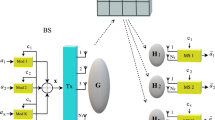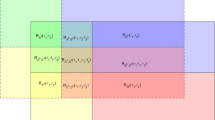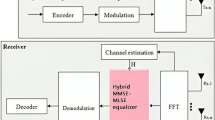Abstract
In this paper, we investigate the performance of a hybrid satellite–terrestrial cooperative relay system, where both of the source-relay and source–destination links experience independent non-identical shadowed-Rician fading while the relay-destination link undergoes uncorrelated Rayleigh fading. By employing maximal-ratio-combining at the destination to combine the signals from the direct link and the fixed-gain relay links, we first obtain the analytical expression for the moment generating function (MGF) of the output signal-to-noise ratio (SNR). Then, with the help of the obtained MGF, we derive the theoretical formulas for the ergodic capacity and average symbol error rate of the considered system. Moreover, the asymptotic analysis at high SNR is also presented to reveal the diversity order and array gain of the system. Finally, the effectiveness of the analytical results is verified through comparison with Monte Carlo simulations.






Similar content being viewed by others
References
Evans, B., Werner, M., Lutz, E., et al. (2005). Integration of satellite and terrestrial systems in future media communications. IEEE Transactions on Wireless Communications, 12(5), 72–80.
Zheng, G., Chatzinotas, S., & Ottersten, B. (2012). Generic optimization of linear precoding in multibeam satellite systems. IEEE Transactions on Wireless Communications, 11(6), 2308–2320.
Zheng, G., Arapoglou, A., & Ottersten, B. (2012). Physical layer security in multibeam satellite systems. IEEE Transactions on Wireless Communications, 11(2), 852–863.
Vanelli-Coralli, A., Corazza, G., Karagiannidis, G., Mathiopoulos, P., Michalopoulos D., Mosquera C., et al. (2007). Satellite communications: Research trends and open issues. In Proceeding of the international workshop on satellite and space communications (IWSSC’07) (pp. 71–75).
Lin, M., Ouyang, J., & Zhu, W. (2016). Joint beamforming and power control for device-to device communications underlaying cellular networks. IEEE Journal on Selected Areas in Communications, 34(1), 138–150.
Ouyang, J., Lin, M., & Zhuang, Y. (2012). Performance analysis of cooperative relay networks over asymmetric fading channels. Electronics Letters, 48(21), 1370–1371.
An, K., Lin, M., Ouyang, J., & Wei, H. (2014). Beamforming in dual-hop AF relaying with imperfect CSI and co-channel interference. Wireless Personal Communications, 78(2), 1187–1197.
Kim, S., Kim, H., Kang, K., & Ahn, D. (2008). Performance enhancement in future mobile satellite broadcasting services. IEEE Communications Magazine, 46(7), 118–124.
Sadek, M., & Aissa, S. (2012). Personal satellite communication: Technologies and challenges. IEEE Wireless Communications, 12(5), 28–35.
An, K., Lin, M., Ouyang, J., Huang, Y., & Zheng, G. (2014). Symbol error analysis on hybrid satellite–terrestrial cooperative networks with co-channel interference. IEEE Communications Letters, 18(11), 1947–1950.
An, K., Ouyang, J., Lin, M., & Liang, T. (2015). Outage analysis of multi-antenna cognitive hybrid satellite–terrestrial relay networks with beamforming. IEEE Communications Letters, 19(7), 1157–1160.
Iqbal, A., & Ahmed, K. M. (2011). A hybrid satellite–terrestrial cooperative network over non identically distributed fading channels. Journal of Communications, 7, 581–589.
Sakarellos, V. K., Kourogiorgas, C., & Panagopoulos, A. D. (2014). Cooperative hybrid land mobile satellite–terrestrial broadcasting systems: Outage probability evaluation and accurate simulation. Wireless Personal Communications, 79(2), 1471–1481.
Sreng, S., Escrig, B., & Boucheret, M.-L. (2013). Exact outage probability of a hybrid satellite terrestrial cooperative system with best relay selection. In Proceedings of the IEEE ICC 2013 (pp. 4520–4524).
Bhatnagar, M. R., & Arti, M. K. (2013). Performance analysis of AF based hybrid satellite–terrestrial cooperative network over generalize. IEEE Communications Letters, 17(10), 1912–1915.
Yeoh, P. L., Elkashlan, M., & Collings, I. B. (2010). Selection relaying with transmit beamforming: A comparison of fixed and variable gain relaying. IEEE Transactions on Vehicle Technology, 59(1), 105–113.
Abdi, A., Lau, W., Alouini, M., & Kaveh, M. (2003). A New simple model for land mobile satellite channels: First-and second-order statistics. IEEE Transactions on Wireless Communications, 2(3), 519–528.
Simon, M., & Alouini, M. (2005). Digital communication over fading channels (p. 86). New York: Wiley/IEEE Press.
Fan, L., Lei, X., & Li, W. (2011). Exact closed-form expression for ergodic capacity of amplify-and-forward relaying in channel-noise-assisted cooperative networks with relay selection. IEEE Communications Letters, 15(3), 332–333.
Li, M., Lin, M., Yu, Q., & Dong, L. (2012). Optimal beamformer design for two hop MIMO AF relay network over Rayleigh fading channels. IEEE Journal on Selected Areas in Communications, 30(8), 3027–3079.
Proakis, J. G. (2011). Digital communications (4th ed.). New York: McGraw-Hill.
Gradshteyn, I. S., Ryzhik, I. M., & Jeffrey, A. (2007). Table of integrals, series, and products (7th ed.). Burlington: Academic Press.
Wang, Z., & Giannakis, G. B. (2003). A simple and general parameterization quantifying performance in fading channels. IEEE Transactions on Communications, 51(8), 1389–1398.
Simon, M. K., & Alouini, M. S. (2000). Digital communications over fading channels: A unified approach to performance analysis. New York: Wiley.
Abramowitz, M., & Stegun, I. A. (1972). Handbook of mathematical function with formulas, graphs, and mathematical tables. 10th, ver publications.
Acknowledgments
This work was supported in part by the National Natural Science Foundation of China under Grants 61271255, by the China Postdoctoral Science Foundation under Grant 2015M571784, by the Natural Science Foundation of Jiangsu Province under Grant BK20131068, by the Jiangsu Planned Projects for Postdoctoral Research Funds under Grant 1402068B, by the Open Research Fund of the National Mobile Communications Research Laboratory of Southeast University under Grant 2012D15, by the Open Research Fund of Key Lab of Broadband Wireless Communication and Sensor Network Technology under Grant NYKL2015010, and by NUPTSF under Grant NY214140.
Author information
Authors and Affiliations
Corresponding author
Appendices
Appendix 1: Proof of Theorem 1
By substituting (7) into (11), \(E\left[ {\gamma_{sd} } \right],E\left[ {\gamma_{sd}^{2} } \right],E\left[ {\gamma_{i} } \right]\) and \(E\left[ {\gamma_{i}^{2} } \right]\) can be calculated as
With the help of the identity [22]
(41) and (42) can be rewritten as
Next, in order to get \(E\left[ {\gamma_{i} } \right]\) and \(E\left[ {\gamma_{{_{i} }}^{2} } \right]\) we focus on the CDF \(\gamma_{i}\) which is given by
where \(F_{{\gamma_{{r_{i} d}} }} \left( x \right)\) is the CDF of \(\gamma_{{r_{i} d}}\) given by
By using (7) and (47), (46) can be rewritten as
where \({}_{1}F_{1} \left( {a,b,z} \right)\) represents the confluent hypergeometric function defined as [22]
with \(\left( x \right)_{n} = x\left( {x + 1} \right)\left( {x + n - 1} \right) = {{\Gamma \left( {x + n} \right)} \mathord{\left/ {\vphantom {{\Gamma \left( {x + n} \right)} {\Gamma \left( x \right)}}} \right. \kern-0pt} {\Gamma \left( x \right)}}\) being the Pochhammer symbol [24]. Thus the \(F_{{\gamma_{i} }} \left( \cdot \right)\) could be rewritten as
where
In deriving (51), we have used the formula \(\left( {t + u} \right)^{n} = \sum\limits_{j = 0}^{n} {\frac{n!}{{j!\left( {n - j} \right)!}}u^{n - j} } t^{j}\). With the help of the identity [22]
where \(K_{n} \left( x \right)\) is the nth order modified Bessel function of the second kind, we have
By substituting (53) into (50), after some algebraic manipulations, \(F_{{\gamma_{i} }} \left( \mu \right)\) can computed as
Using the (54) into (11) with m = 1 and m = 2, respectively, we have
With the application of the formula [22]
where \(W_{k,m} \left( \cdot \right)\) is Whittaker function given by [25]
where \(U\left( { \cdot , \cdot ; \cdot } \right)\) is the confluent hypergeometric function of the second kind [22], after some calculation, (55) and (56) can be written as
Appendix 2: Proof of Theorem 2
The fixed gain constant C in (3) can be written as
To obtain \(E\left[ {\gamma_{{sr_{i} }} } \right]\), we substitute (3) into (8), and yield
With the help of (43), one can obtain
The fixed-gain constant C is thus given by
Appendix 3: Proof of Theorem 3
Substituting (46) into (23), after some algebraic manipulations, the expression of \(M_{{\gamma_{i} }} \left( s \right)\) is given by
where
By using (57) and (58), it follows that
Substituting (67) into (65), we can get
Rights and permissions
About this article
Cite this article
Bu, YJ., Lin, M., An, K. et al. Performance Analysis of Hybrid Satellite–Terrestrial Cooperative Systems with Fixed Gain Relaying. Wireless Pers Commun 89, 427–445 (2016). https://doi.org/10.1007/s11277-016-3278-9
Published:
Issue Date:
DOI: https://doi.org/10.1007/s11277-016-3278-9




